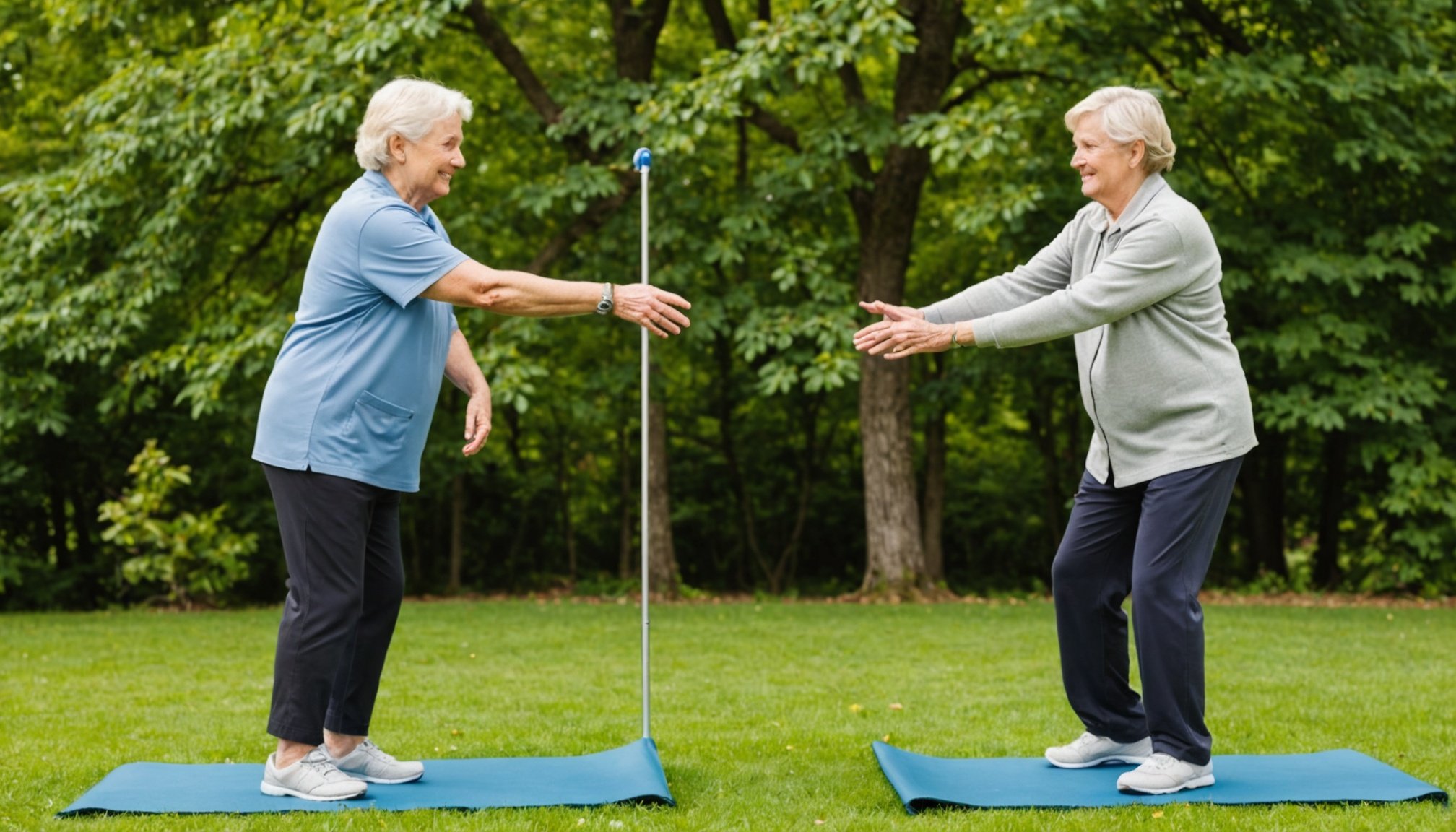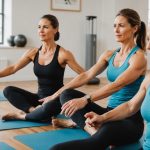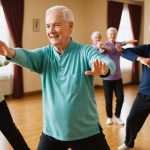Importance of Balance Exercises for Seniors
As seniors age, balance exercises become crucial for maintaining quality of life. Increasing seniors’ mobility is essential for both physical health and independence. The risk of falls is a significant concern, as factors such as muscle deterioration, medication side effects, and environmental hazards can significantly elevate the risk. Therefore, incorporating balance exercises into daily routines is a proactive way to enhance stability and reduce these risks.
Enhancing balance not only aids in fall prevention but also improves overall health. Engaging in regular balance exercises can lead to stronger muscles, better coordination, and heightened flexibility. These factors collectively contribute to more robust physical strength and confidence, especially among older adults. Seniors who consistently participate in such exercises report an increased ability to perform daily activities with ease.
Also to see : Exploring Cutting-Edge Remote Health Monitoring Technologies for Seniors: The Latest Innovations!
Moreover, the connection between balance exercises and increased independence cannot be overstated. With stronger balance and mobility, seniors are less reliant on caregivers, allowing them more freedom to engage in social activities and maintain an active lifestyle. This fosters not just physical well-being but also emotional satisfaction, as autonomy is a critical component of a fulfilling life. Encouraging your loved ones to incorporate balance exercises can be a significant step towards a healthier, safer, and more independent life journey.
Effective Balance Exercises
Improving balance is crucial for stability and preventing falls. Balance exercises can greatly enhance your coordination and strength. Let’s explore some proven techniques.
Also to discover : Top Strategies for Seniors: Mastering Chronic Pain Management
Standing on One Leg
Start with the most fundamental exercise: standing on one leg. This activity engages the core, enhances stability, and is easy to practise anywhere. To perform, raise one foot slightly off the ground while standing straight, holding the position for 10 to 30 seconds. Gradually increase the duration as you gain confidence. Beginners can use a chair or wall for support. This simple yet effective balance exercise is adaptable to all fitness levels.
Heel-to-Toe Walk
Another effective technique is the heel-to-toe walk. It simulates real-life balance challenges by requiring precise foot placement. Walk forward in a straight line, placing one heel directly in front of the other foot’s toes with each step. If necessary, use a rail for balance. This exercise strengthens the legs and improves posture, offering excellent training for everyday activities.
Sit-to-Stand
The sit-to-stand exercise focuses on leg strength and stability. Sit in a sturdy chair, feet flat, shoulder-width apart, and arms crossed over your chest. Stand up without using your hands, then slowly return to a sitting position. This movement boosts lower body strength and balance, with modifications available for those who require additional support.
Tips for Safe Practice
Prioritising safety tips in your exercise routine is crucial for effective and injury-free workouts. Incorporating a warm-up and cool-down routine is essential to prepare your body for physical activity and aid recovery. A solid warm-up gradually elevates your heart rate and increases blood flow to the muscles, reducing the possibility of strains. Meanwhile, a cool down progressively lowers your heart rate and incorporates stretching to improve flexibility and prevent stiffness.
Selecting a suitable environment is pivotal for fall risk reduction. Choose areas that are flat and devoid of clutter to minimise the risk of accidents. This precaution not only ensures freedom of movement but also provides focus without unnecessary distractions that could lead to missteps.
Additionally, integrating supportive equipment during exercise can significantly enhance safety. Consider using chairs or wall support for stability, especially when attempting balance exercises or trying new movements. This assistance can provide confidence and security, particularly for those who may be less experienced or have mobility concerns.
By adhering to these exercise precautions, you create a safer and more efficient workout experience. Ensuring a conducive space and employing necessary support will empower you to engage in physical activity with assurance and minimise potential risks.
Proven Benefits of Balance Exercises
The health benefits of balance exercises are backed by compelling research, particularly in enhancing mobility improvement and providing fall prevention evidence. Studies have shown that these exercises significantly reduce fall rates, particularly among seniors, by strengthening the muscles and improving coordination. With age, stability can decrease, making falls more likely. Fortunately, practicing balance exercises regularly bolsters stability, reducing this risk.
Greater confidence in daily motions is one impact of these exercises on seniors. As their mobility improvement becomes noticeable, they gain the assurance to perform activities that might have seemed daunting before. Walking, climbing stairs, and even dancing become more accessible, enhancing their quality of life.
Long-term health benefits are another compelling reason to incorporate balance exercises into a routine. Regular practice can lead to better posture and joint stability, which help prevent injuries over time. It also improves overall physical fitness, aiding in cardiovascular health and muscle endurance. For seniors, this means not only maintaining independence longer but also enjoying a fuller, more active lifestyle.
By focusing on these exercises, individuals can bolster their physical resilience, thus fostering safer and more confident movement in their everyday lives.
Expert Insights and Testimonials
When it comes to understanding the importance of balance training, the insights from health professionals are invaluable. Experts emphasize that incorporating balance exercises into daily routines can significantly enhance one’s stability and reduce the risk of falls. According to Dr. James Morris, a renowned physiotherapist, “Balance exercises are crucial for maintaining mobility and independence in seniors. They help in strengthening the core muscles and improving coordination.”
Success Stories
Take the story of Grace, a 72-year-old retiree who struggled with her balance after a minor fall. After attending balance training sessions recommended by her physiotherapist, she experienced a remarkable transformation. Grace shared, “I no longer fear a simple walk in the garden. My confidence has returned.” Such success stories highlight the profound impact balance training can have on seniors.
Practical Advice
Integrating balance exercises into your routine doesn’t have to be daunting. Professionals suggest starting with simple tasks, like standing on one leg while brushing your teeth. Gradually, these exercises can become a natural part of your day. Remember, as Dr. Morris advises, “Consistency is key. Aim for balance exercises at least three times a week for the best results.”
Listening to expert opinions and learning from testimonials can motivate you to make balance exercises an essential part of your lifestyle.
Visual Aids and Resources
Understanding and mastering balance exercises can be greatly enhanced through the use of instructional videos, imagery, and exercise resources. These aids provide clarity and guidance for individuals looking to improve their techniques.
Demonstration Videos
Instructional videos serve as an excellent tool for those who prefer visual learning. They offer step-by-step guidance, helping users to imitate movements accurately. You can find resources on platforms like YouTube or specialized fitness websites. These videos often feature experienced trainers demonstrating proper form and technique, aiding in the prevention of injuries. Beneficial for both beginners and advanced practitioners, videos provide varying levels of difficulty to cater to different needs.
Infographics on Balance Techniques
Infographics simplify complex balance techniques by breaking them down into easy-to-follow visuals. These graphical representations highlight key elements of exercises, making it easier for users to grasp important concepts quickly. They frequently include tips and common mistakes to avoid, serving as a quick reference guide when practising independently. Many fitness platforms offer downloadable infographics focused on enhancing balance skills.
Printable Exercise Charts
Having access to exercise resources such as printable charts is essential. These charts serve as practical guides that can be easily referenced during workouts. They often include descriptions, posture corrections, and sequence layouts for exercises. Additionally, they allow individuals to track progress over time, ensuring steady improvement in balance skills. They are a staple in any home workout setup.
Conclusion on Balance and Fall Prevention
Enhancing stability and mobility can significantly improve well-being, especially among seniors. A recap of techniques for achieving this includes consistent practice of balance exercises such as tai chi, yoga, and simple one-legged stands. These activities not only strengthen muscles but also enhance proprioception — the body’s awareness of movement and position.
Fall prevention relies heavily on routine. By incorporating exercises multiple times a week, seniors can maintain independence and reduce the risk of injuries. Encouraging older adults to engage regularly can prevent detrimental impacts on their lifestyle caused by falls.
It’s crucial to emphasize that improving balance isn’t just about avoiding accidents. Enhancing equilibrium can lead to a more active, fulfilling life, allowing individuals to participate in activities they love without fear. The impact of good balance extends beyond safety; it contributes to overall quality of life.
Remember, maintaining balance and engaging in regular physical activity can be empowering. It provides both physical and mental health benefits, making it an essential part of daily routines. Make the effort today to invest in a stable and vibrant future.











